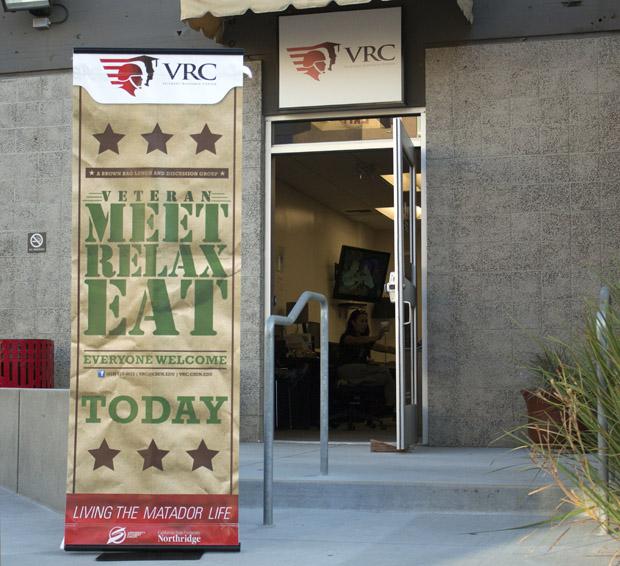
The number of veteran students in higher education has been on the rise since WWII, and CSUN’s Veteran Resource Center (VRC) is one of the institutions that help ease the transition for veterans into college life.
The Post-9/11 GI Bill offers more assistance to veterans than the prior Montgomery GI Bill, but some educational institutions are struggling with providing veterans the “meaningful information” promised to service members through an executive order issued in 2012.
A study done by the American Council on Education shows that of the almost 700 surveyed institutions, 62 percent currently provide programs and services specifically designed for military service members and veterans, and approximately 71 percent indicated these services were part of their long-term strategic plan.
CSUN’s VRC opened last fall for the more than 700 veterans on campus, and although their foot traffic has increased over the past two semesters, they continue to work on bringing awareness to their presence.
Claudio Caldarescu, a supervisor at the VRC, said the center sees about 30 people a day, many who are regulars.
“Our main objective here is to help military members transition over as students,” he said.
He said the VRC doesn’t actually process any paperwork, such as documents for GI Bill benefits, but they have all of the information and contacts a veteran would be seeking.
“If anyone comes in here with a problem, usually within minutes it’s solved because…more than likely one of us in here experienced that so we can help them right away,” he said.
Caldarescu said the most common issue veterans encounter is transitioning from the extremely structured lifestyle of the military into a student lifestyle where that structure is absent. He also said that misconceptions of veterans sometimes make veterans feel isolated, exacerbating difficulties of this transition.
“Maybe they don’t know exactly what a veteran is. Maybe they think it’s just somebody who goes out and goes to war and shoots and maybe that intimidates a lot of people,” Caldarescu said.
This is why he greatly encourages non-veteran students to come hang out at the VRC, not only to break down the barriers formed from these misconceptions, but in order to help the veterans possibly learn from those who are used to a less-structured lifestyle.
The situation at CSUN appears to be drastically different than that at CSULA, according to the LA Times.They reported in early October that a group representing the 400 veterans at CSULA voted no confidence in the administration.
They complained officials have failed to follow through on a proposal to establish a resource center, and Cal State Chancellor Timothy White said he agreed that, “we have not addressed the identified needs of our student veterans in a timely manner.”
However, the LA Times also reported that of the CSU’s 23 campuses which have enrolled nearly 7,000 veterans and active duty members in 2012, all but a handful of campuses have established a resource center, according the CSU Spokesman Mike Uhlenkamp.
With CSUN’s VRC already open, their focus now is just trying to bring awareness to their presence, according to Caldarescu. He said it’s harder at CSUN since it’s a commuter campus and since many veterans also have families, which results in many students going straight back home after school and therefore not exploring the campus.
Another common problem he has noticed is with financial aid. Since the VRC doesn’t handle the paperwork, they instead directly connect them with the Veterans Affairs (VA) office on campus.
On the front desk at the VRC there is a stack of business cards, one of them for the VA Coordinator Eloisa Smith. Caldarescu eagerly pulled out a map of the school campus on which he then highlighted the route to the VA’s office.
He said it would be more ideal if they were right next door, as the VA’s office is in Bayramian Hall, a little ways from the VRC which is on the more eastern end of the USU. However Caldarescu did say that Smith has helped in their efforts to provide awareness of the VRC to students.
So far Neon Nights, the VRC’s main event, has proved successful in attracting more students than last semester. After combining their efforts with USU, the first Neon Nights of this year brought more than 100 students together.
Every first Thursday of the month for Neon Nights the VRC and USU buy out the Games Room in the USU so that all games are free, and they also provide free food.
Additionally, on Nov. 22 at the Pub Sports Grill, the VRC and CSUN’s Student Veteran Organization are co-hosting Operation Comedy where professional comedians with a military background will be performing.
Caldarescu emphasized that non-veterans are more than welcome, saying that the VRC wants veterans to get out of their military pack and spread out.
“We make a huge effort to go around become familiar with all the different departments on campus and if somebody has a question or an issue, we actually have a contact. From what I see and hear from everybody, it’s huge to have this.”





